人教版(2019)选择性必修 第一册Unit 4 Body language Using language Ⅱ 课件(共32张PPT)
文档属性
| 名称 | 人教版(2019)选择性必修 第一册Unit 4 Body language Using language Ⅱ 课件(共32张PPT) | 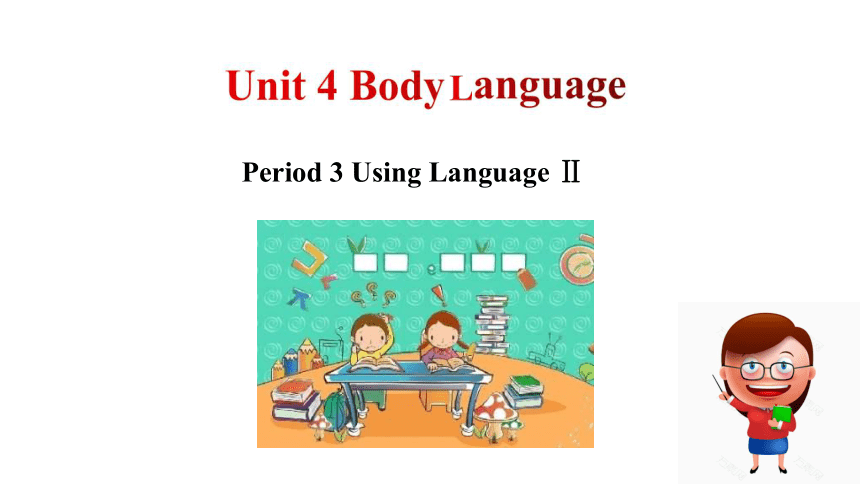 | |
| 格式 | pptx | ||
| 文件大小 | 2.6MB | ||
| 资源类型 | 教案 | ||
| 版本资源 | 人教版(2019) | ||
| 科目 | 英语 | ||
| 更新时间 | 2024-11-21 12:24:45 | ||
图片预览

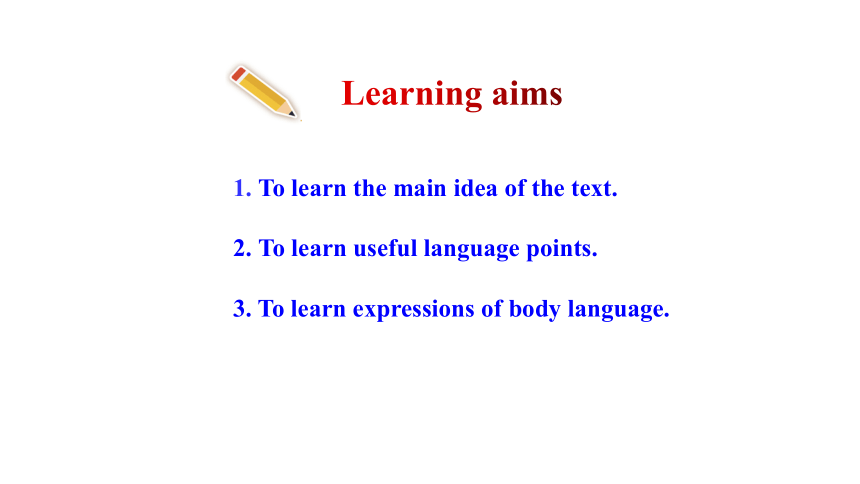
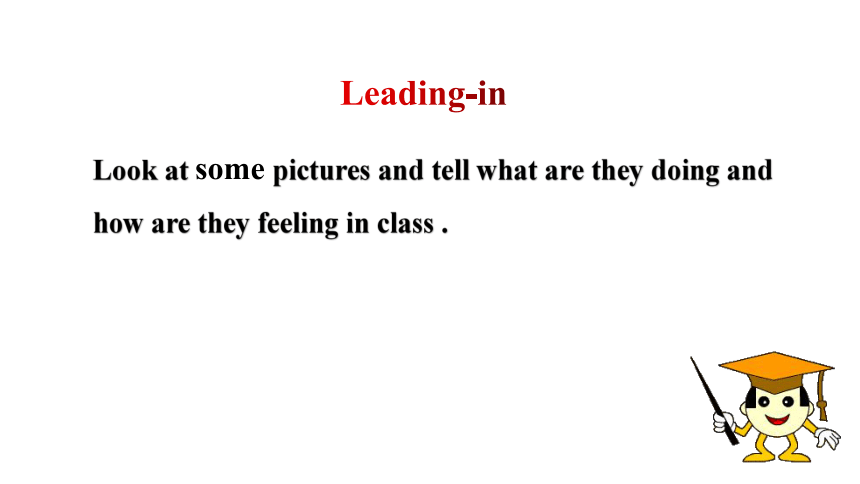
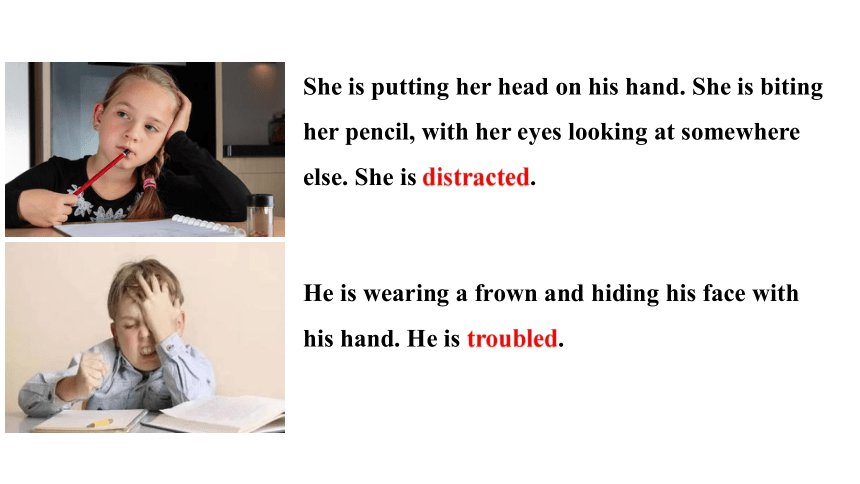
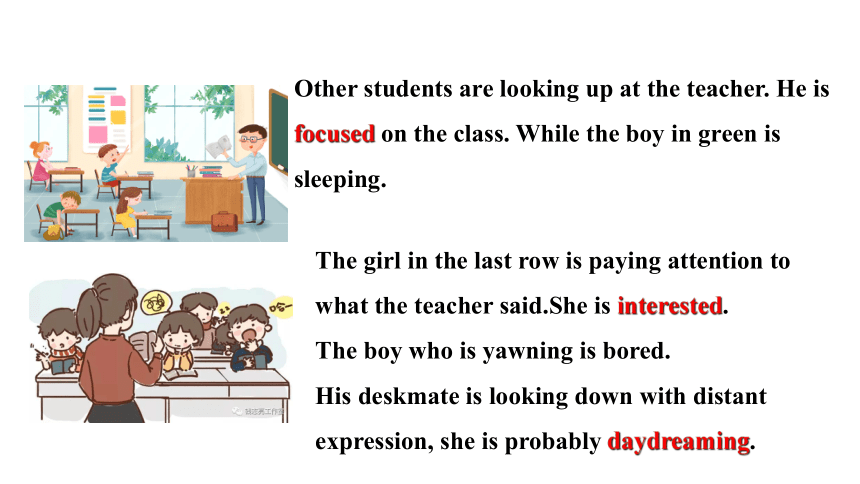

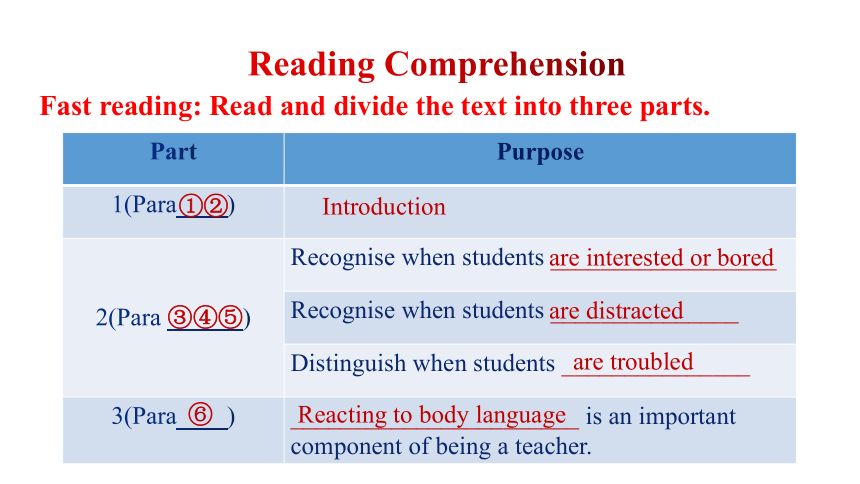
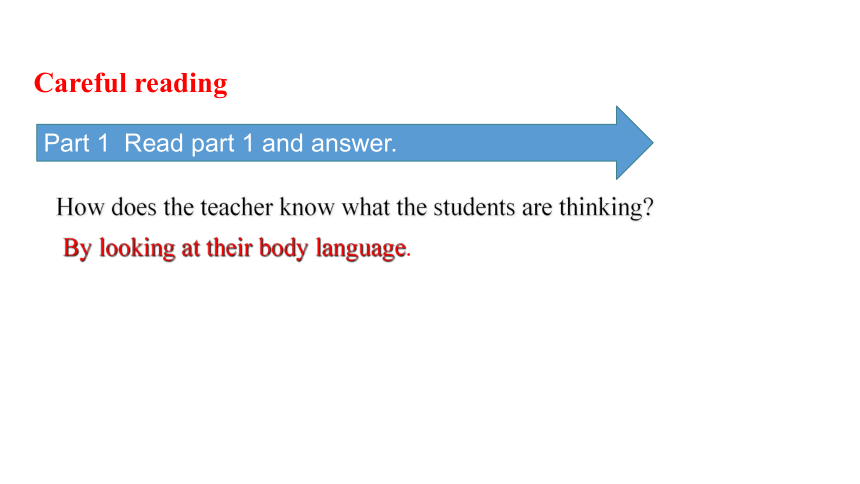
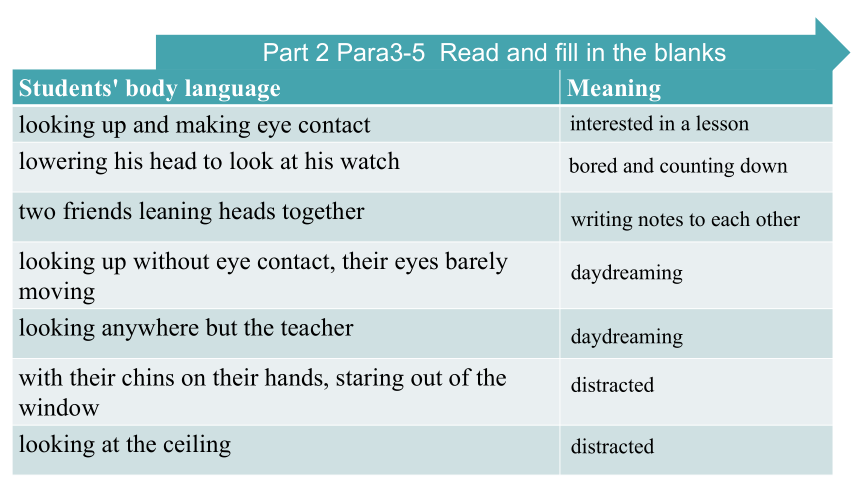
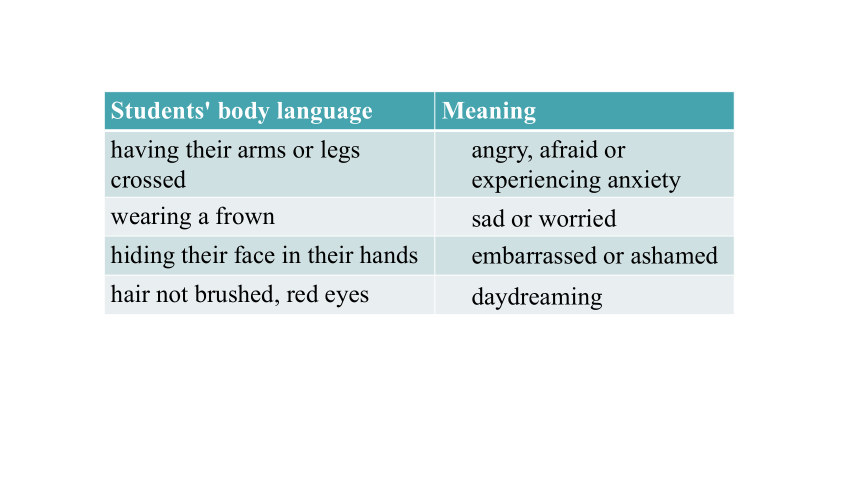
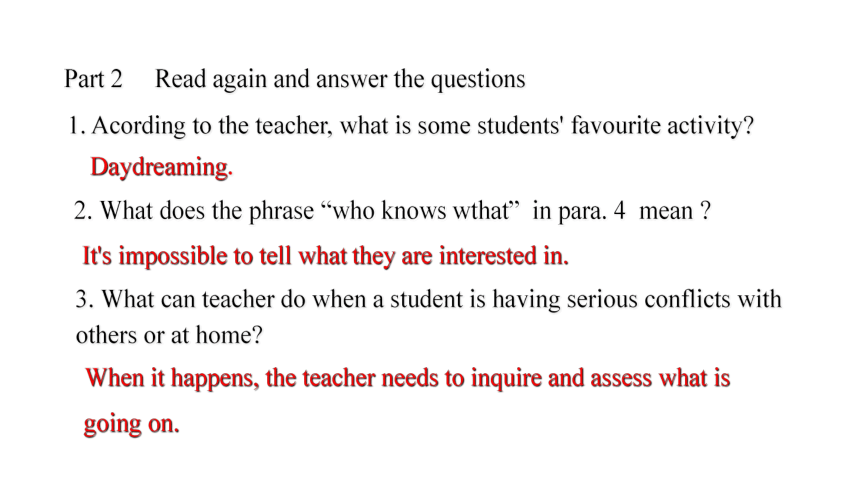
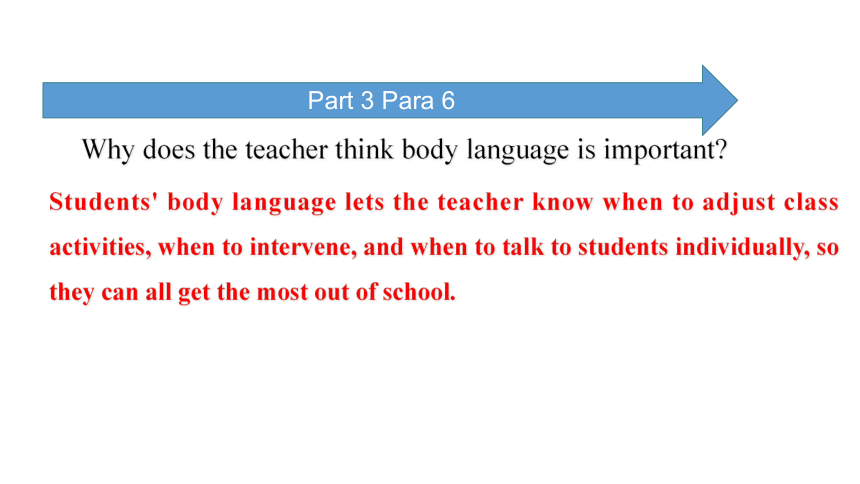
文档简介
(共32张PPT)
Period 3 Using Language Ⅱ
Learning aims
1. To learn the main idea of the text.
2. To learn useful language points.
3. To learn expressions of body language.
Leading-in
Look at some pictures and tell what are they doing and
how are they feeling in class .
She is putting her head on his hand. She is biting her pencil, with her eyes looking at somewhere else. She is distracted.
He is wearing a frown and hiding his face with his hand. He is troubled.
Other students are looking up at the teacher. He is focused on the class. While the boy in green is sleeping.
The girl in the last row is paying attention to what the teacher said.She is interested.
The boy who is yawning is bored.
His deskmate is looking down with distant expression, she is probably daydreaming.
How do I know my students
Reading Comprehension
Part Purpose
1(Para____)
2(Para ______) Recognise when students __________________
Recognise when students _______________
Distinguish when students _______________
3(Para____) _______________________ is an important component of being a teacher.
Introduction
are interested or bored
are distracted
are troubled
Reacting to body language
①②
③④⑤
⑥
Fast reading: Read and divide the text into three parts.
Reading Comprehension
Part 1 Read part 1 and answer.
How does the teacher know what the students are thinking
By looking at their body language.
Careful reading
Students' body language Meaning
looking up and making eye contact
lowering his head to look at his watch
two friends leaning heads together
looking up without eye contact, their eyes barely moving
looking anywhere but the teacher
with their chins on their hands, staring out of the window
looking at the ceiling
interested in a lesson
bored and counting down
writing notes to each other
daydreaming
daydreaming
distracted
distracted
Part 2 Para3-5 Read and fill in the blanks
Students' body language Meaning
having their arms or legs crossed
wearing a frown
hiding their face in their hands
hair not brushed, red eyes
angry, afraid or experiencing anxiety
sad or worried
embarrassed or ashamed
daydreaming
Part 2 Read again and answer the questions
1. Acording to the teacher, what is some students' favourite activity
Daydreaming.
2. What does the phrase “who knows wthat” in para. 4 mean
It's impossible to tell what they are interested in.
3. What can teacher do when a student is having serious conflicts with others or at home
When it happens, the teacher needs to inquire and assess what is going on.
Why does the teacher think body language is important
Students' body language lets the teacher know when to adjust class activities, when to intervene, and when to talk to students individually, so they can all get the most out of school.
Part 3 Para 6
As a teacher, I try to know 1. each student is thinking by watching their body language. Recognizing whether students are 2.________(interest) in a lesson is easy. Most students tend to look up and make eye contact and sometimes they lean forward and look at me. If a student looks 3. at his watch, it implies he is bored. If two friends are leaning their heads together, they are 4. (probable) writing notes to each other.
Some students are easy to be 5. (distract). Instead of looking at me, they spend all their time looking anywhere. Then again, some students prefer daydreaming.
what
interested
down
probably
distracted
Fill in the blanks.
6. their chins on their hands,they occupy 7._________ (them) by staring out of the window or up at the ceiling. In these cases, they should be reminded to concentrate.
Distinguishing when students are troubled is much 8._________ (hard). If students have their arms crossed in front of their chests and their legs 9. (close) or crossed, it shows they are angry, afraid, or experiencing anxiety.
Finally, it is my duty to help every student to learn and I adjust class 10. ____ (activity) according to their body language. In my opinion, reacting to body language is an important component of being a teacher.
With
themselves
harder
closed
activities
1.tendency n. 倾向,趋势;癖好
There is a tendency towards regional cooperation. 有一种地区性合作的趋势。
a tendency to/towards...的倾向
tend vi. & vt. 趋向,倾向;照料,照顾
tend to do倾向于; 往往会
Language points
【知识拓展】
【即学即练】
(1)Today there is a tendency for people __________(drop) out of social activity.
(2) (2021·全国乙卷)These days, safety regulations—not to mention the modern sports fan’s desire for a good view and a comfortable seat—tend ________ (keep) stadium capacities(容量)slightly lower.
(3) (2023·全国甲卷) I _________________________________ to state parks or to the countryside to go on adventures and take photos along the way. 我倾向于和几个朋友一起去州立公园旅行或去乡村探险,沿途拍照。
to drop
to keep
tend to travel with a few of my friends
2. occupy vt. 占据,占领;占用;居住;使忙碌
(2023·全国甲卷)Grizzly bears, which may grow to about 2.5 m long and weigh over 400 kg, occupy a conflicted corner of the American psyche.
灰熊可以长到2.5米长,体重超过400公斤,在美国人的心理中占据着一个矛盾的角落。
【知识拓展】
occupy oneself with sth./doing sth... = be busy with/doing
occupation n. 职业;占有;消遣;占有期;复数 occupations
occupational adj. 职业的;占领的
【即学即练】
(1) 他忙着装那辆车。
(2)你为什么对这个职业感兴趣?
(3)______________(occupation) schools have been set up to train people in jobs that they may be better suited for.
职业学校已经被建立起来,以便培训人们从事他们可能更适合的工作。
He occupied himself with packing the car.
Why are you interested in this occupation
Occupational
3.distinguish vt. 区分;辨别;使杰出,使表现突出
He is the most distinguished scholar in this field.
他是这一领域成就最为卓著的学者。
distinguish between A and B=distinguish A from B区分……
be distinguished for因……而出名
【即学即练】
(1)(2021·浙江高考)Dogs may indeed be able to distinguish _________ happy and angry human faces, according to a new study.
(2)It was getting light and shapes were more ______________(distinguish).
between
【知识拓展】
distinguishable
4. bother vt. & vi. 烦扰,打扰;使……不安;使……恼怒
I'm terribly sorry to bother you at this hour.
我非常抱歉这个时候来打搅您。
【知识拓展】
bother to do/doing sth. 操心/费心做某事
bother sb. with sth. 用某事打扰某人
bother sb. to do sth. 麻烦某人做某事
【即学即练】
(1) He didn’t even bother_________(say) thank you.
他甚至连说一声谢谢都不肯。
(2)I’m sorry to bother you ________ so many questions on such an occasion.
在这种情况下,我还问了你这么多问题,给你添麻烦了。
to say
with
5. adjust vt.调整;调节 vi.& vt.适应;(使)习惯
Animals can adjust themselves to the environment.
动物能自己适应环境。
【知识拓展】
adjust...to (doing) sth. 调整……以适应(做)某事
adjust oneself to 使自己适应于……
adjustment n. 调整;调节;适应
make an adjustment to 对……做出调整
【即学即练】
(1) We have been preparing our fighters to adjust ___________(they) to civil society.
我们一直在培训我们的战士,以使他们适应普通的社会生活。
(2) She made a few minor _____________(adjust) to the focus of her camera.
她对相机的焦距做了一些小的调整。
themselves
adjustments
Writing
假如你是李华,你校校报的英文版就身势语的差异进行征稿。请你根据以下表格内容完成一个关于中美身势语差异的英文稿件。
身势语 美国 中国
身体接触 保持距离,较少接触,尤其是同性之间 身体接触较多,例如女性之间可以手拉手等
伸舌头 一种粗鲁的表现 一种尴尬的表现
拍小孩的头 给予安慰或鼓励 表示喜爱
注意:1.短文应包括表格所示的全部内容,可适当发挥;
2.词数80左右,文章开头已为你写好,不计入总词数。
1. 审题定调
主题 中美身势语的差异 体裁 说明文
人称 第一、三人称为主 时态 一般现在时
布局 第一段:强调身势语的重要性,表明写作目的; 第二段:根据表格提示,说明身体接触、伸舌头和拍小孩的头的中美差异; 第三段:总结差异是客观存在的,提出彼此理解的希望。 2. 遣词造句
(1)遣词: 用本单元所学单词或短语填空
1.______________ adv.几乎不;勉强才能;刚刚
2.______________ n.手势;姿势;姿态
3.______________ adj.难堪的;尴尬的
4.______________ adj.羞愧;惭愧
5.______________ n.帮助;恩惠;赞同
6.______________ n.差别;差异
7.______________ adv.合适地;适当地
8.______________ 相比之下
9.______________ 站近
barely
gesture
embarrassed
ashamed
favour
appropriately
difference
by comparison
stand close to
(2)造句
(1)从表格中我们可以看到这种情况。
We can____________________________the table.
(2)中国女性经常手牵手走路。
Women in China often____________________________.
(3)这在美国并不常见。
It____________________________common in America.
(4)美国人通常站得离彼此不是很近。
Americans usually____________________________each other.
(5)他们几乎不碰对方,尤其是同性之间。
They________________________each other, especially for people of the same sex.
see this situation from
walk hand in hand
is not always
don't stand close to
barely touch
3.连句成篇
As we have more communication with foreigners, we should pay more attention to the differences in the body language.
As we see from the table, women in China often walk hand in hand, which is not always common in America. By comparison, Americans usually don't stand close to each other and they barely touch each other, especially for people of the same sex. Also, Americans think it rude to put out one's tongue, but the Chinese often use this gesture language when they are embarrassed or ashamed. Furthermore, Chinese people will pat children on the head if they like them, and Americans do so as well when they want to express favour or comfort.
In a word, differences do exist; only by fully understanding the differences in body language can we communicate appropriately.
词汇
清单
核心短语
应用词汇:1.tend:a tendency to/towards..., tend to do...
2.occupy: occupy oneself with sth./doing sth.... = be busy with/doing
3.distinguish: distinguish between A and B=distinguish A from B, be distinguished for
4. bother: bother to do/doing sth,bother sb. with sth., bother sb. to do sth.
5. adjust: adjust...to (doing) sth, adjust oneself to, make an adjustment to
call on, at work, at the same time, make a joke, pay attention, have conflicts with, react to, rob sb. of sth.
认知词汇:tick, chin, distract, intervene
拓展词汇:educate→ educator→ education;tend→tendency ,imply→implication; occupy→ occupation; distinguish→distinguished
Summary
While it is easy to perceive when students are interested,bored,or distracted,it is sometimes much harder to distinguish when students are troubled.(While引导让步状语从句)
重点句式
1.The report suggested that the same trend was______work in politics.
2.I had forgotten all about the party because I had been so occupied
______other things.
3.On the Internet,we can know what is going______all over the world.
4.It was often hard to work and do the course______the same time.
5.It took her a long time to adjust ______living alone in America.
Exercise
at
with
on
at
to
1.With the development of technology, we have a___________(趋势;倾向)to lead a more convenient life.
2.I still miss the old times when we___________(使用)the farm and raised a lot of poultry(家禽).
3.A good teacher can___________(察觉到) his students' sorrow by the looks on their faces.
4.The twins were so much alike that it was impossible to___________(辨别) one from the other.
5.He was so ___________(尴尬的)because he made a mistake.
tendency
occupied
perceive
distinguish
embarrassed
The water that bears the boat is the same that swallows it up.
水能载舟,亦能覆舟。
Period 3 Using Language Ⅱ
Learning aims
1. To learn the main idea of the text.
2. To learn useful language points.
3. To learn expressions of body language.
Leading-in
Look at some pictures and tell what are they doing and
how are they feeling in class .
She is putting her head on his hand. She is biting her pencil, with her eyes looking at somewhere else. She is distracted.
He is wearing a frown and hiding his face with his hand. He is troubled.
Other students are looking up at the teacher. He is focused on the class. While the boy in green is sleeping.
The girl in the last row is paying attention to what the teacher said.She is interested.
The boy who is yawning is bored.
His deskmate is looking down with distant expression, she is probably daydreaming.
How do I know my students
Reading Comprehension
Part Purpose
1(Para____)
2(Para ______) Recognise when students __________________
Recognise when students _______________
Distinguish when students _______________
3(Para____) _______________________ is an important component of being a teacher.
Introduction
are interested or bored
are distracted
are troubled
Reacting to body language
①②
③④⑤
⑥
Fast reading: Read and divide the text into three parts.
Reading Comprehension
Part 1 Read part 1 and answer.
How does the teacher know what the students are thinking
By looking at their body language.
Careful reading
Students' body language Meaning
looking up and making eye contact
lowering his head to look at his watch
two friends leaning heads together
looking up without eye contact, their eyes barely moving
looking anywhere but the teacher
with their chins on their hands, staring out of the window
looking at the ceiling
interested in a lesson
bored and counting down
writing notes to each other
daydreaming
daydreaming
distracted
distracted
Part 2 Para3-5 Read and fill in the blanks
Students' body language Meaning
having their arms or legs crossed
wearing a frown
hiding their face in their hands
hair not brushed, red eyes
angry, afraid or experiencing anxiety
sad or worried
embarrassed or ashamed
daydreaming
Part 2 Read again and answer the questions
1. Acording to the teacher, what is some students' favourite activity
Daydreaming.
2. What does the phrase “who knows wthat” in para. 4 mean
It's impossible to tell what they are interested in.
3. What can teacher do when a student is having serious conflicts with others or at home
When it happens, the teacher needs to inquire and assess what is going on.
Why does the teacher think body language is important
Students' body language lets the teacher know when to adjust class activities, when to intervene, and when to talk to students individually, so they can all get the most out of school.
Part 3 Para 6
As a teacher, I try to know 1. each student is thinking by watching their body language. Recognizing whether students are 2.________(interest) in a lesson is easy. Most students tend to look up and make eye contact and sometimes they lean forward and look at me. If a student looks 3. at his watch, it implies he is bored. If two friends are leaning their heads together, they are 4. (probable) writing notes to each other.
Some students are easy to be 5. (distract). Instead of looking at me, they spend all their time looking anywhere. Then again, some students prefer daydreaming.
what
interested
down
probably
distracted
Fill in the blanks.
6. their chins on their hands,they occupy 7._________ (them) by staring out of the window or up at the ceiling. In these cases, they should be reminded to concentrate.
Distinguishing when students are troubled is much 8._________ (hard). If students have their arms crossed in front of their chests and their legs 9. (close) or crossed, it shows they are angry, afraid, or experiencing anxiety.
Finally, it is my duty to help every student to learn and I adjust class 10. ____ (activity) according to their body language. In my opinion, reacting to body language is an important component of being a teacher.
With
themselves
harder
closed
activities
1.tendency n. 倾向,趋势;癖好
There is a tendency towards regional cooperation. 有一种地区性合作的趋势。
a tendency to/towards...的倾向
tend vi. & vt. 趋向,倾向;照料,照顾
tend to do倾向于; 往往会
Language points
【知识拓展】
【即学即练】
(1)Today there is a tendency for people __________(drop) out of social activity.
(2) (2021·全国乙卷)These days, safety regulations—not to mention the modern sports fan’s desire for a good view and a comfortable seat—tend ________ (keep) stadium capacities(容量)slightly lower.
(3) (2023·全国甲卷) I _________________________________ to state parks or to the countryside to go on adventures and take photos along the way. 我倾向于和几个朋友一起去州立公园旅行或去乡村探险,沿途拍照。
to drop
to keep
tend to travel with a few of my friends
2. occupy vt. 占据,占领;占用;居住;使忙碌
(2023·全国甲卷)Grizzly bears, which may grow to about 2.5 m long and weigh over 400 kg, occupy a conflicted corner of the American psyche.
灰熊可以长到2.5米长,体重超过400公斤,在美国人的心理中占据着一个矛盾的角落。
【知识拓展】
occupy oneself with sth./doing sth... = be busy with/doing
occupation n. 职业;占有;消遣;占有期;复数 occupations
occupational adj. 职业的;占领的
【即学即练】
(1) 他忙着装那辆车。
(2)你为什么对这个职业感兴趣?
(3)______________(occupation) schools have been set up to train people in jobs that they may be better suited for.
职业学校已经被建立起来,以便培训人们从事他们可能更适合的工作。
He occupied himself with packing the car.
Why are you interested in this occupation
Occupational
3.distinguish vt. 区分;辨别;使杰出,使表现突出
He is the most distinguished scholar in this field.
他是这一领域成就最为卓著的学者。
distinguish between A and B=distinguish A from B区分……
be distinguished for因……而出名
【即学即练】
(1)(2021·浙江高考)Dogs may indeed be able to distinguish _________ happy and angry human faces, according to a new study.
(2)It was getting light and shapes were more ______________(distinguish).
between
【知识拓展】
distinguishable
4. bother vt. & vi. 烦扰,打扰;使……不安;使……恼怒
I'm terribly sorry to bother you at this hour.
我非常抱歉这个时候来打搅您。
【知识拓展】
bother to do/doing sth. 操心/费心做某事
bother sb. with sth. 用某事打扰某人
bother sb. to do sth. 麻烦某人做某事
【即学即练】
(1) He didn’t even bother_________(say) thank you.
他甚至连说一声谢谢都不肯。
(2)I’m sorry to bother you ________ so many questions on such an occasion.
在这种情况下,我还问了你这么多问题,给你添麻烦了。
to say
with
5. adjust vt.调整;调节 vi.& vt.适应;(使)习惯
Animals can adjust themselves to the environment.
动物能自己适应环境。
【知识拓展】
adjust...to (doing) sth. 调整……以适应(做)某事
adjust oneself to 使自己适应于……
adjustment n. 调整;调节;适应
make an adjustment to 对……做出调整
【即学即练】
(1) We have been preparing our fighters to adjust ___________(they) to civil society.
我们一直在培训我们的战士,以使他们适应普通的社会生活。
(2) She made a few minor _____________(adjust) to the focus of her camera.
她对相机的焦距做了一些小的调整。
themselves
adjustments
Writing
假如你是李华,你校校报的英文版就身势语的差异进行征稿。请你根据以下表格内容完成一个关于中美身势语差异的英文稿件。
身势语 美国 中国
身体接触 保持距离,较少接触,尤其是同性之间 身体接触较多,例如女性之间可以手拉手等
伸舌头 一种粗鲁的表现 一种尴尬的表现
拍小孩的头 给予安慰或鼓励 表示喜爱
注意:1.短文应包括表格所示的全部内容,可适当发挥;
2.词数80左右,文章开头已为你写好,不计入总词数。
1. 审题定调
主题 中美身势语的差异 体裁 说明文
人称 第一、三人称为主 时态 一般现在时
布局 第一段:强调身势语的重要性,表明写作目的; 第二段:根据表格提示,说明身体接触、伸舌头和拍小孩的头的中美差异; 第三段:总结差异是客观存在的,提出彼此理解的希望。 2. 遣词造句
(1)遣词: 用本单元所学单词或短语填空
1.______________ adv.几乎不;勉强才能;刚刚
2.______________ n.手势;姿势;姿态
3.______________ adj.难堪的;尴尬的
4.______________ adj.羞愧;惭愧
5.______________ n.帮助;恩惠;赞同
6.______________ n.差别;差异
7.______________ adv.合适地;适当地
8.______________ 相比之下
9.______________ 站近
barely
gesture
embarrassed
ashamed
favour
appropriately
difference
by comparison
stand close to
(2)造句
(1)从表格中我们可以看到这种情况。
We can____________________________the table.
(2)中国女性经常手牵手走路。
Women in China often____________________________.
(3)这在美国并不常见。
It____________________________common in America.
(4)美国人通常站得离彼此不是很近。
Americans usually____________________________each other.
(5)他们几乎不碰对方,尤其是同性之间。
They________________________each other, especially for people of the same sex.
see this situation from
walk hand in hand
is not always
don't stand close to
barely touch
3.连句成篇
As we have more communication with foreigners, we should pay more attention to the differences in the body language.
As we see from the table, women in China often walk hand in hand, which is not always common in America. By comparison, Americans usually don't stand close to each other and they barely touch each other, especially for people of the same sex. Also, Americans think it rude to put out one's tongue, but the Chinese often use this gesture language when they are embarrassed or ashamed. Furthermore, Chinese people will pat children on the head if they like them, and Americans do so as well when they want to express favour or comfort.
In a word, differences do exist; only by fully understanding the differences in body language can we communicate appropriately.
词汇
清单
核心短语
应用词汇:1.tend:a tendency to/towards..., tend to do...
2.occupy: occupy oneself with sth./doing sth.... = be busy with/doing
3.distinguish: distinguish between A and B=distinguish A from B, be distinguished for
4. bother: bother to do/doing sth,bother sb. with sth., bother sb. to do sth.
5. adjust: adjust...to (doing) sth, adjust oneself to, make an adjustment to
call on, at work, at the same time, make a joke, pay attention, have conflicts with, react to, rob sb. of sth.
认知词汇:tick, chin, distract, intervene
拓展词汇:educate→ educator→ education;tend→tendency ,imply→implication; occupy→ occupation; distinguish→distinguished
Summary
While it is easy to perceive when students are interested,bored,or distracted,it is sometimes much harder to distinguish when students are troubled.(While引导让步状语从句)
重点句式
1.The report suggested that the same trend was______work in politics.
2.I had forgotten all about the party because I had been so occupied
______other things.
3.On the Internet,we can know what is going______all over the world.
4.It was often hard to work and do the course______the same time.
5.It took her a long time to adjust ______living alone in America.
Exercise
at
with
on
at
to
1.With the development of technology, we have a___________(趋势;倾向)to lead a more convenient life.
2.I still miss the old times when we___________(使用)the farm and raised a lot of poultry(家禽).
3.A good teacher can___________(察觉到) his students' sorrow by the looks on their faces.
4.The twins were so much alike that it was impossible to___________(辨别) one from the other.
5.He was so ___________(尴尬的)because he made a mistake.
tendency
occupied
perceive
distinguish
embarrassed
The water that bears the boat is the same that swallows it up.
水能载舟,亦能覆舟。
